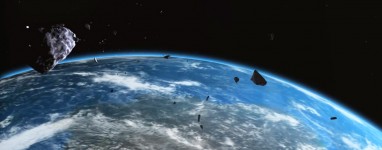



On a daily basis, about one hundred tons of interplanetary material drifts down to the Earth’s surface. Most of the smallest interplanetary particles that reach the Earth’s surface are the tiny dust particles that are released by comets as their ices vaporize in the solar neighborhood. The vast majority of the larger interplanetary material that reaches the Earth’s surface originates as the collision fragments of asteroids that have run into one another some eons ago.

With an average interval of about 10,000 years, rocky or iron asteroids larger than about 100 meters would be expected to reach the Earth’s surface and cause local disasters or produce the tidal waves that can inundate low lying coastal areas. On an average of every several hundred thousand years or so, asteroids larger than a kilometer could cause global disasters. In this case, the impact debris would spread throughout the Earth’s atmosphere so that plant life would suffer from acid rain, partial blocking of sunlight, and from the firestorms resulting from heated impact debris raining back down upon the Earth’s surface. Since their orbital paths often cross that of the Earth, collisions with near-Earth objects have occurred in the past and we should remain alert to the possibility of future close Earth approaches. It seems prudent to mount efforts to discover and study these objects, to characterize their sizes, compositions and structures and to keep an eye upon their future trajectories.
Because of the ongoing search efforts to find nearly all the large NEOs, objects will occasionally be found to be on very close Earth approaching trajectories. Great care must then be taken to verify any Earth collision predictions that are made. Given the extremely unlikely nature of such a collision, almost all of these predictions will turn out to be false alarms. However, if an object is verified to be on an Earth colliding trajectory, it seems likely that this collision possibility will be known several years prior to the actual event. Given several years warning time, existing technology could be used to deflect the threatening object away from Earth. The key point in this mitigation process is to find the threatening object years ahead of time so that an orderly international campaign can be mounted to send spacecraft to the threatening object. One of the techniques suggested for deflecting an asteroid includes nuclear fusion weapons set off above the surface to slightly change the asteroid’s velocity without fracturing it. High speed neutrons from the explosion would irradiate a shell of material on the surface of the asteroid facing the explosion. The material in this surface shell would then expand and blow off, thus producing a recoil upon the asteroid itself. A very modest velocity change in the asteroid’s motion (only a few millimeters per second), acting over several years, can cause the asteroid to miss the Earth entirely. However, the trick is to gently nudge the asteroid out of harm’s way and not to blow it up. This latter option, though popular in the movies, only creates a bigger problem when all the pieces encounter the Earth. Another option that has been discussed includes the establishment of large solar sails on a small threatening object so that the pressure of sunlight could eventually redirect the object away from its predicted Earth collision.
No one should be overly concerned about an Earth impact of an asteroid or comet. The threat to any one person from auto accidents, disease, other natural disasters and a variety of other problems is much higher than the threat from NEOs. Over long periods of time, however, the chances of the Earth being impacted are not negligible so that some form of NEO insurance is warranted. At the moment, our best insurance rests with the NEO scientists and their efforts to first find these objects and then track their motions into the future. We need to first find them, then keep an eye on them.